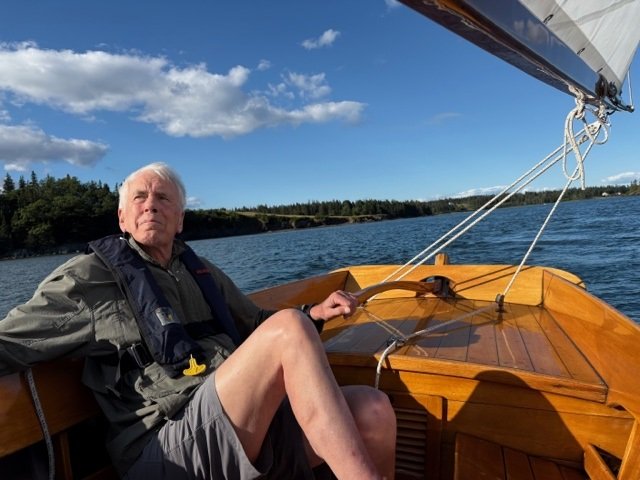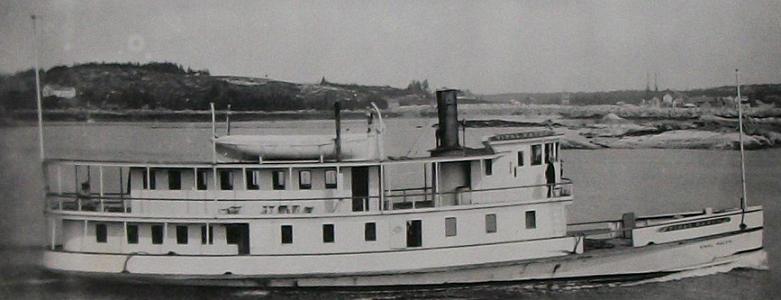-
Posts
1,308 -
Joined
-
Last visited
Content Type
Profiles
Forums
Gallery
Events
Everything posted by TBlack
-
Keith, That looks like a lot of filing and cutting to shape the blade; how are your fingers holding up? RE: staysail tacking: back in the old days (1950's) I spent summers on an Alden schooner that came with a fisherman's staysail (Quadrilateral between main and fore above the foresail) and we had to lower it and rerig when coming about, if that's any help. Tom
-

Recommendations For A Good Milling Machine
TBlack replied to Thistle17's topic in Modeling tools and Workshop Equipment
Joe, I'm with you on the learning curve. I did get the rotary table and angle table and the slitting saw. The former because Danny told me to, the latter because KeithAug showed how to use it in building bulkheads with great precision. I have used the machine in rudimentary operations, but I've also made some cannon carriage sides in 1:96 using the DRO feature with great success. If this machine were a woman, I'd marry her! Tom -

Recommendations For A Good Milling Machine
TBlack replied to Thistle17's topic in Modeling tools and Workshop Equipment
Joe, Interesting coincidence, I followed along with your discussion because I also was in the market. And I came to the same conclusions as you did. I got the 5410 DRO, as I like to deal in millimeters. The DRO is a great attachment and very accurate; a huge addition for precision! Tom -
Bob, I've been quietly following along on your build. I feel compelled to come out of the shadows and remark on your wonderful workmanship, and, as I recall, without the benefit of power tools! The joinery is fantastic. Tom
- 682 replies
-
- halifax
- lumberyard
-
(and 1 more)
Tagged with:
-
Keith, I'm looking at your "sketches" and I'm convinced that you have an engineering background; most of us don't do such detailed drawings . And I will reiterate what I wrote before: we need to package up this log and save it for other budding shipwrights. Tom
-

Dremel Drill pess adapter
TBlack replied to Derek C's topic in Modeling tools and Workshop Equipment
I'd agree with the comments that suggest the stand will not produce really accurate results. Suppose you're trying to make a pin rack for your belaying pins; the holes have to be evenly spaced and all in line. Can't do it with this appliance. If your tolerances are broader and you feel that with rope coils over the belaying pins nobody will see slight misalignments, the stand will do the job. I've had one for years and still use it, but I line everything up before hand; mark where I want the hole; turn on the dremel, and there's enough slop in the stand that the torque of the drill throws it out of alignment. Tom -
I've decided that there are 2 kinds of logs on this site. There are those that show us what the builder has done and there are those that show us not only what the builder has done, but how he/she did it. I think this log needs to be especially preserved not only for the approach that Keith takes to solve problems but also as an inspiration for the rest of us to try it. And, Keith, I'm going to be in Coventry in Oct., but I guess that's quite a long way from Sussex; otherwise, I would visit you in a minute. Tom
-

SS Mariefred by captainbob - 1:96
TBlack replied to captainbob's topic in - Build logs for subjects built 1901 - Present Day
Difficult and sudden news. I certainly enjoyed Bob's contributions, insight and positive attitude. Darnit! TB -

Recommendations For A Good Milling Machine
TBlack replied to Thistle17's topic in Modeling tools and Workshop Equipment
Well, darnit! Kat never offered me a 15% discount (I'm 74). But I'm certainly happy with the product. It's giving me an opportunity to be a lot more precise. TB -

Recommendations For A Good Milling Machine
TBlack replied to Thistle17's topic in Modeling tools and Workshop Equipment
Joe, As the modern folks say, "My bad". In the search box put in "schooner Altair". Tom -

Recommendations For A Good Milling Machine
TBlack replied to Thistle17's topic in Modeling tools and Workshop Equipment
Joe, Take a look at Keith's log (Altair); his entry #9 on the first page shows how he gets accurate cuts with the mill in producing bulkheads for his model. I need to try that, and while I have zero experience with a mill, I think I can do what Keith does. I did get the mill equipped with the 10,000 RPM pulley set, as several folks here thought it might make smoother cuts in wood. I also got the accessory set which includes end mills (I think 2 flute). I suspect I'm going to have to augment them with 3 or 4 flute end mills. I'll let you know if I think all this is worth it. Tom -

Recommendations For A Good Milling Machine
TBlack replied to Thistle17's topic in Modeling tools and Workshop Equipment
Joe, I've been tagging along on your coattails with the same question about the appropriate mill. As a result of your inquiries, I've just ordered a Sherline with a rotary table and tilt table (thanks Danny). And if you have been following KeithAug's Altair build, you've seen his unique way of using a slitting saw in the mill. So I thought I'd should get a slitting saw set-up as well. Tom -

Recommendations For A Good Milling Machine
TBlack replied to Thistle17's topic in Modeling tools and Workshop Equipment
Thanks Danny; I'll do it. But one more thought: 2 flutes or 4 flutes on the end mill? I'll be working in brass and hardwood. Tom -

Recommendations For A Good Milling Machine
TBlack replied to Thistle17's topic in Modeling tools and Workshop Equipment
I agree with you, Thistle, lots of good advice. I was going to buy a rotary table and an angle bracket to hold it vertically, but I'm reading that the tilting table is a better idea? I'm not sure how I would use that feature, but if Dan thinks it's a good idea, ok. Will that mean that I can build models like Dan does? Tom -

Recommendations For A Good Milling Machine
TBlack replied to Thistle17's topic in Modeling tools and Workshop Equipment
Dear all, This has been a very helpful conversation; thank you Thistle for starting it. It does bring up an interesting point though: at what spindle speed can you cut hardwood cleanly? And does the Sherline get there? Tom -

Recommendations For A Good Milling Machine
TBlack replied to Thistle17's topic in Modeling tools and Workshop Equipment
You and I are in the same boat: owners of a unimat lathe and looking for a suitable mill. I had focused on the weight of the machine. I think the sherline comes in at around 100 lbs. while the German and Chinese machines are considerably heavier than that....more machine than I need? I'll be interested in what others here think. Tom -
Keith, Sorry to be late to the party, and fabulous work that you are doing. Do you suppose the slack line that runs along the bottom of the main boom is a topping lift? Tom
-

Casting Propellers
TBlack replied to steamschooner's topic in Metal Work, Soldering and Metal Fittings
From my point of view, this is the brilliance in this project. Tom -
Denis, Once upon a time I would look at your work and think, "I can do that". But, somehow, you've changed. You've gone WAY beyond me! Good work, wonderful pal. TB
-

SS Mariefred by captainbob - 1:96
TBlack replied to captainbob's topic in - Build logs for subjects built 1901 - Present Day
I am not proud of my hulls and it is definitely not the way I see everyone else doing it. So I paint my hulls to cover up the mess. Now did you really want to see all that? Actually, I do the same thing, so I don't need to see it; I know how to do that already. Press on... Tom -
Sjors, Nice job! I make the start date as Jan 1, 2014. Given the size of this project, mighty fast work, I'm thinking. Incidentally, where do you display this art work? Not exactly coffee table sized! Tom
- 1,616 replies
-
- caldercraft
- agamemnon
-
(and 1 more)
Tagged with:
-
John, I love to see someone else work in 1:96 scale also...gives me comfort. Also, I see some differences in rigging and deck furniture from one painting to the next. Go with the latter? Tom
-

SS Mariefred by captainbob - 1:96
TBlack replied to captainbob's topic in - Build logs for subjects built 1901 - Present Day
Hi Bob That was fast work! Is the horizontal line the waterline? And the shoulder on the bulkhead is where the main deck lies? TB -

SS Mariefred by captainbob - 1:96
TBlack replied to captainbob's topic in - Build logs for subjects built 1901 - Present Day
Bob Glad to see you tackle this project. Looks a little like the one I did a couple of years ago: Tom -
Bob, I don't know how you could be more careful. Don't think about it too much. We love your work and your careful explanations. For me, I like the fact that you are also adept with the software. You're an inspiration! TB
About us
Modelshipworld - Advancing Ship Modeling through Research
SSL Secured
Your security is important for us so this Website is SSL-Secured
NRG Mailing Address
Nautical Research Guild
237 South Lincoln Street
Westmont IL, 60559-1917
Model Ship World ® and the MSW logo are Registered Trademarks, and belong to the Nautical Research Guild (United States Patent and Trademark Office: No. 6,929,264 & No. 6,929,274, registered Dec. 20, 2022)
Helpful Links
About the NRG
If you enjoy building ship models that are historically accurate as well as beautiful, then The Nautical Research Guild (NRG) is just right for you.
The Guild is a non-profit educational organization whose mission is to “Advance Ship Modeling Through Research”. We provide support to our members in their efforts to raise the quality of their model ships.
The Nautical Research Guild has published our world-renowned quarterly magazine, The Nautical Research Journal, since 1955. The pages of the Journal are full of articles by accomplished ship modelers who show you how they create those exquisite details on their models, and by maritime historians who show you the correct details to build. The Journal is available in both print and digital editions. Go to the NRG web site (www.thenrg.org) to download a complimentary digital copy of the Journal. The NRG also publishes plan sets, books and compilations of back issues of the Journal and the former Ships in Scale and Model Ship Builder magazines.



